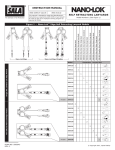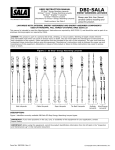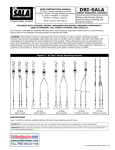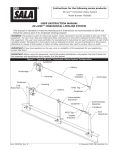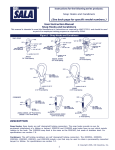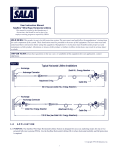Download USER INSTRUCTION MANUAL WRAPBAX™2
Transcript
Instructions for the following series products: WrapBax™2 Lanyards (See back page for specific model numbers.) User Instruction Manual WrapBax™2 Lanyards With Integral Energy Absorbers This manual is intended to meet the Manufacturer’s Instructions as recommended by OSHA, and should be used as part of an employee training program. Figure 1 - WrapBax™ Lanyards WrapBax™2 shock absorbing lanyard, WrapBax hook at one end, snap hook at the other end. WrapBax™2 shock absorbing lanyard, 100% tie off, WrapBax hooks at ends, snap hook at the other end. WrapBax™2 shock absorbing lanyard, WrapBax hook at one end, web loop at the other end. WrapBax™2 shock absorbing lanyard, 100% tie off, WrapBax hooks at ends, web loop at the other end. WrapBax™2 lanyard with Force 2 shock absorber, WrapBax hook at one end, snap hook at the other end. Other models and options, not shown, are available. ARNING: This product is part of a personal restraint, work positioning, suspension, or rescue system. These W instructions must be provided to the user and rescuer (see section 8.0 Terminology). The user must read and understand these instructions or have them explained to them before using this equipment. The user must read and follow the manufacturer’s instructions for each component or part of the complete system. Manufacturer’s instructions must be followed for proper use and maintenance of this product. Alterations or misuse of this product or failure to follow instructions may result in serious injury or death. IMPORTANT: If you have any questions on the use, care, application, or suitability for use of this equipment, contact DBI-SALA. IMPORTANT: Before using this equipment record the product identification information (found on the I.D. label) in the inspection and maintenance log in section 9.0 of this manual. DESCRIPTIONS WrapBax™2 HOOK WEB LANYARDS 1 3/16 in. web, WrapBax™2 hook on one end, 9503175 snap hook on the other end. 1 3/16 in. web, WrapBax™2 hook on the 100% tie-off ends, 9503175 snap hook on the other end. 1 3/16 in. web, WrapBax™2 hook on one end, web loop on the other end. 1 3/16 in. web, WrapBax™2 hook on the 100% tie-off ends, web loop on the other end. FORCE 2™ WrapBax™2 HOOK WEB LANYARD 1 3/16 in. web, WrapBax™2 hook on one end, 9503175 snap hook on the other end. © Copyright 2007, DB Industries, Inc. 1.0 APPLICATIONS 1.1 PURPOSE: DBI-SALA WrapBax Energy Absorbing Lanyards are intended to be used as part of a personal fall arrest system. Applications for these products include inspection work, construction and demolition, maintenance, oil production, confined space rescue, and other similar activities where there exists the possibility of an accidental fall. This equipment is specially designed to dissipate fall energy and limit fall arrest forces transferred to the body. The WrapBax hook lanyards allow the lanyard to be wrapped around an anchor and to be attached back onto itself. 1.2 The following application limitations must be considered before using this product: A. CAPACITY: This equipment is for use by persons with a combined weight (person, clothing, tools, etc.) of no more than 310 lbs., except for Force 2 Model No. 1222102, capacity: 420 lbs. B. PHYSICAL AND ENVIRONMENTAL HAZARDS: Use of this equipment in areas containing physical or environmental hazards may require that additional precautions be taken to reduce the possibility of damage to this equipment or injury to the user. Hazards may include, but are not limited to; high heat, strong or caustic chemicals, corrosive environments, the possibility of electric current flowing through this equipment when working near high voltage power lines, explosive or toxic gases, moving machinery, or sharp edges. Contact DBI-SALA if you have any questions about the application of this equipment in areas where physical or environmental hazards are present. C. TRAINING: This equipment is intended to be installed and used by persons who have been properly trained in its correct application and use. 1.3 Refer to national Standards including ANSI Z359 (.0, .1, .2, .3, and .4) family of standards on fall protection, ANSI A10.32, and applicable local, state and federal (OSHA) requirements governing occupational safety for more information about work positioning systems. 2.0 SYSTEM REQUIREMENTS 2.1 COMPATIBILITY OF COMPONENTS: DBI-SALA equipment is designed for use with DBI-SALA approved components and subsystems only. Substitutions or replacements made with non-approved components or subsystems may jeopardize compatibility of equipment and may effect the safety and reliability of the complete system. 2.2 COMPATIBILITY OF CONNECTORS: Connectors are considered to be compatible with connecting elements when they have been designed to work together in such a way that their sizes and shapes do not cause their gate mechanisms to inadvertently open regardless of how they become oriented. Contact DBISALA if you have any questions about compatibility. Connectors ( hooks, carabiners, and D-rings) must be capable of supporting at least 5,000 lbs. (22.2kN). Connectors must be compatible with the anchorage or other system components. Do not use equipment that is not compatible. Non-compatible connectors may unintentionally disengage. See Figure 2. Connectors must be compatible in size, shape, and strength. Self locking snap hooks and carabiners are required by ANSI Z359.1 and OSHA. 2.3 MAKING CONNECTIONS: Only use self-locking snap hooks and carabiners with this equipment. Only use connectors that are suitable to each application. Ensure all connections are compatible in size, shape and strength. Do not use equipment that is not compatible. Ensure all connectors are fully closed and locked. DBI-SALA connectors (snap hooks and carabiners) are designed to be used only as specified in each product’s user’s instructions. See Figure 3 for inappropriate connections. DBI-SALA snap hooks and carabiners should not be connected: A. To a D-ring to which another connector is attached. B. In a manner that would result in a load on the gate. NOTE: Large throat opening snap hooks should not be connected to standard size D-rings or similar objects which will result in a load on the gate if the hook or D-ring twists or rotates. Large throat snap hooks are designed for use on fixed structural elements such as rebar or cross members that are not shaped in a way that can capture the gate of the hook. C. In a false engagement, where features that protrude from the snap hook or carabiner catch on the anchor and without visual confirmation seems to be fully engaged to the anchor point. D. To each other. E. Directly to webbing or rope lanyard or tie-back (unless the manufacturer’s instructions for both the lanyard and connector specifically allows such a connection). Figure 2 - Unintentional Disengagement (Roll-out) If the connecting element that a snap hook (shown) or carabiner attaches to is undersized or irregular in shape, a situation could occur where the connecting element applies a force to the gate of the snap hook or carabiner. This force may cause the gate (of either a self-locking or a non-locking snap hook) to open, allowing the snap hook or carabiner to disengage from the connecting point. Small ring or other non-compatibly shaped element 1. Force is applied to the snap hook. 2. The gate presses against the connecting ring. NOTE: The WrapBax hook and lanyard are designed to have the lanyard pass through the hook in order to tie off to an anchor in a choking manner. Never pass a lanyard (standard or WrapBax) through any other type of hook or carabiner. Never pass a standard lanyard through a WrapBax hook. Serious injury or death could result if this lanyard is misused. F. 3. The gate opens allowing the snap hook to slip off. Figure 3 - Inappropriate Connections To any object which is shaped or dimensioned such that the snap hook or carabiner will not close and lock, or that roll-out could occur. 2.4 ANCHORAGE STRENGTH: Anchorages selected for work positioning systems shall have a strength capable of sustaining static loads applied in the directions permitted by the system of at least: A) 3,000 pounds (13.3 kN) for non-certified anchorages or B) Two times the foreseeable force for certified anchorages (see section 8 Terminology). When more than one work positioning system is attached to an anchorage, the strengths previously set forth in (A) and (B) shall be multiplied by the number of systems attached to the anchorage. Per OSHA 1926.500 and 1910.66 - Anchorages used for attachment of PFAS shall be independent of any anchorage being used to support or suspend platforms, and capable of supporting at least 5,000 lbs. per user attached, or be designed, installed, and used as part of a complete PFAS which maintains a safety factor of at least two, and is supervised by a qualified person. 3.0 OPERATION AND USE WARNING: Do not alter or intentionally misuse this equipment. Consult DBI‑SALA when using this equipment in combination with components or subsystems other than those described in this manual. Some subsystem and component combinations may interfere with the operation of this equipment. Use caution when using this equipment around moving machinery and electrical hazards. Do not loop the lanyard around small structural members. WARNING: Consult your doctor if there is reason to doubt your fitness to safely absorb the shock from a fall arrest. Age and fitness seriously affect a worker’s ability to withstand falls. Pregnant women or minors must not use DBI-SALA energy absorbing lanyards. 3.1 BEFORE EACH USE of this equipment, carefully inspect it to assure that it is in good working condition. Check for worn or damaged parts. Ensure all hardware is present and secure, and is not distorted or have any sharp edges, burrs, cracks, or corrosion. Ensure self locking snap hooks or carabiners work properly. Inspect rope or webbing for wear, cuts, burns, frayed edges, breaks, or other damage. See section 5.0 for further inspection details. Do not use if inspection reveals an unsafe condition. 3.2 PLAN your fall protection system before starting your work. Take into consideration factors that affect your safety before, during, and after a fall. The following list gives some important points to consider when planning your system: A. ANCHORAGE: Select a rigid anchorage point that is capable of supporting the required loads. See section 2.4. The anchorage location must be carefully selected to reduce possible free fall and swing fall hazards and to avoid striking an object during a fall. The anchorage should be generally level (horizontal) to prevent the anchorage connector from sliding down an incline when in use, which could cause serious injury to the user. B. FREE FALL: Personal fall arrest systems must be rigged such that the potential free fall is never greater than 6 feet. Avoid working above your anchorage level to avoid an increased free fall distance. If you are using a WrapBax lanyard with a Force2 energy absorber, it may be used in applications where the free fall may exceed 6 feet (12 feet maximum), provided the employer can document that arresting force limits are maintained and the assembled system will operate properly. Be sure to check the label on the shock absorber to determine that it is a Force2 shock absorber before using a lanyard in those situations. See section 7.3 of this manual for test documentation for typical harness systems using the Force2 energy absorber. DBI-SALA recommends consulting OSHA on free fall restrictions in your specific industry to be assured of compliance. Figure 4 - Fall Clearance: WrapBax Energy Absorbers C. FALL ARREST FORCES: The assembled fall arrest system must keep fall arrest forces below 1,800 lbs. when used with a full body harness. WrapBax™ Fall Clearance LL= Lanyard Length The Lanyard length may be shortened by the amount of lanyard wrapped around the anchor. D. FALL CLEARANCE: Should a fall occur, there DD=Energy absorber Deceleration Distance must be sufficient clearance in the fall area (3 1/2 feet total). LL to arrest the fall before striking the ground HH= Height of the Harness dorsal D-ring or other object. The user must determine from the worker’s feet. if the system will arrest a fall within the C = Clearance to nearest obstruction during fall arrest (1 1/2 feet required plus clearance available. Some factors that affect 1 foot for D-ring movement and system materials strech - 2 1/2 feet total). this determination include: anchorage location, RD RD= Required Distance below the anchor to connecting subsystem (lanyard), and the length DD nearest obstruction. of the connecting subsystem. See Figure 4 for RD = LL + DD + HH + C estimating fall clearance when using a WrapBax energy absorbing lanyard or Figure 5 for HH determining clearance when using a WrapBax lanyard with a Force2 energy absorbing lanyard attached to a fixed anchorage. Check the lanyard Nearest Obstruction label carefully to determine which model you are using. The WrapBax lanyard energy absorbers C can extend the fall arrest distance by up to 3.5 feet. If using a Force2 energy absorber Figure 5 - Fall Clearance: Force 2 Energy Absorbers allow 3.5 feet of extension where the free fall WrapBax™ Force™2 Fall Clearance is ten feet or less, and 4.3 feet of extension where the free fall is more than 10 feet (12 ft. LL= Lanyard Length maximum). Some full body harness models The Lanyard length may be shortened by the amount of lanyard wrapped incorporate a sliding (positional) D-ring in the around the anchor. back as the fall arrest attachment, movement DD=Energy absorber Deceleration Distance (4 1/2 feet total). of this D-ring during fall arrest can increase the fall clearance distance required. Use caution HH= Height of the Harness dorsal D-ring from the worker’s feet. when assembling system components that C = Clearance to nearest obstruction during could act to extend the fall arrest distance (and fall arrest (1 1/2 feet required plus 1 foot for D-ring movement and system therefore the fall clearance required). Refer to LL materials stretch - 2 1/2 feet total). manufacturer’s instructions for each part of the RD= Required Distance below the anchor to system for more information on fall clearance. nearest obstruction. Figure 5 is for systems using the Force2 energy RD = LL + DD + HH + C absorbing lanyards only. When using the Force2 RD energy absorbing lanyard with other fall arrest DD equipment, such as rope grabs or horizontal lifelines, follow the instructions included with that equipment to evaluate the fall clearance. E. SWING FALLS: Swing falls occur when the anchorage point is not directly above the point where a fall occurs. The force of striking an object while swinging (horizontal speed of the user due to the pendulum affect) can be great HH Nearest Obstruction C and may cause serious injury. In a swing fall situation, the total vertical fall distance of the user will be greater than if the user had fallen vertically directly below the anchorage point. The user must therefore account for an increase in the total free fall distance and the area needed to safely arrest the fall. Swing falls can be minimized by working as directly below the anchorage point as possible. Never permit a swing fall if injury could occur. If a swing fall situation exists in your application contact DBI-SALA before proceeding. See Figure 6. Figure 6 - Swing Fall Hazard F. SHARP EDGES: Avoid working where the lanyard, subsystem, or other system components will be in contact with, or abrade against, unprotected sharp edges. Do not loop lanyard around small diameter structural members. If working with this equipment near sharp edges is unavoidable, protection against cutting must be provided by using a heavy pad or other means over the exposed sharp edge. G. RESCUE: Should a fall occur, the user (employer) must have a rescue plan and the ability to implement it. H. AFTER A FALL: Lanyards with integral energy absorbers, or energy absorber components which have been subjected to the forces of arresting a fall must be removed from service and destroyed. WARNING: Read and follow manufacturer’s instructions for associated equipment (full body harness, rope grab, etc.) used in your fall protection system. IMPORTANT: For special (custom) versions of this product, follow the instructions herein. If included, see supplement for additional instructions. 3.3 MAKING CONNECTIONS: Snap hooks and WrapBax hooks operate in the same manner. Grip the hook handle in one hand. With your index finger, depress the locking mechanism in. With your thumb, pull back the gate latch. As the gate latch is pulled back, the gate will open. Release your grip and the gate will close. (See Figure 7.) Wrap the lanyard around an appropriate anchor (see section 2.4), then open the gate of the WrapBax hook and pass the lanyard through the hook. See Figure 8. The lanyard may make more than one wrap around the anchor, but the lanyard may only be passed through the WrapBax hook once. Make sure the lanyard is captured and the gate closes completely. Figure 7 - Snap Hook and WrapBax Hook Operation Pull back gate with thumb Pull back gate with thumb Depress locking mechanism with index finger Depress locking mechanism with index finger Step 1 Step 2 Step 1 Step 2 Figure 8 - Attaching the WrapBax WARNING: Only the WrapBax hook may be used to snap back directly onto the WrapBax lanyard. When using a hook to connect to an anchorage, or when coupling components of the system together, ensure accidental disengagement (roll-out) cannot occur. Roll-out occurs when interference between a hook and the mating connector causes the hook’s gate or keeper to accidentally open and release. Roll-out may occur when a hook is connected to an undersized ring such as an eye bolt or other noncompatible shaped connector. Self locking snap hooks or self locking and self closing gate carabiners should be used to reduce the possibility of roll-out when making connections. Do not use hooks or connectors that will not completely close over the attachment object. For these situations, use a tie-off adaptor or other anchorage connector to allow a compatible connection. Do not knot lanyard in any manner. Snap hooks and carabiners must not be connected to each other. Do not attach snap hooks to web loops. A. CONNECTING TO ANCHORAGE OR ANCHORAGE CONNECTOR: See Figure 9. Always connect the energy absorber end of the lanyard to the body support (harness). Connect the lanyard end to the anchorage or anchorage connector. Component style energy absorbers should be connected to the body support first, then coupled to the rest of the system. Some anchorage connector devices may be supplied with permanently attached energy absorber. Use of an additional energy absorber or energy absorbing lanyard with these types of subsystems is not recommended. 100% tie-off “Y” type energy absorbing lanyards can be used to provide continuous fall protection while ascending, descending, or moving laterally. With one lanyard leg attached, the worker can move to a new location, attach unused lanyard leg, and disconnect attached leg. This procedure is repeated until new location is reached. B. Figure 9 - Connecting to Anchorage Anchorage Anchorage Energy Absorbing Lanyard Energy Absorbing Lanyard CONNECTING TO THE BODY SUPPORT: Connect the energy absorbing lanyard or energy absorber to the Dring on the back between the shoulders (dorsal D-ring) on a full body harness. Connect so the energy absorber portion of the lanyard is on the body support side. DBISALA does not recommend using a body belt for fall arrest applications. Attaching a Lanyard with Web Loops: See Figure 10. Step 1. Insert the energy absorbing lanyard web loop through the harness web loop or D-ring. Figure 10 - Attaching A Web Loop Insert the lanyard web loop through the web loop or D-ring on the harness Step 2. Insert the opposite end of the energy absorbing lanyard through the connecting web loop. Step 3. Pull the attached energy absorbing lanyard through the connecting web loop to secure. Harness web loop or D-ring Web loop on energy absorbing lanyard Insert opposite end of the lanyard through the lanyard web loop. C. CONNECTING TO A ROPE GRAB (FALL ARRESTOR): It is recommended the lanyard end (vs. the energy absorber end) be attached to the rope grab. This recommendation is made to reduce possible interference with the operation of the rope Pull the lanyard through the lanyard web loop grab by the energy absorber pack. Attaching a component style to secure. energy absorber to a rope grab is not recommended, with the exception of a direct-coupling between a rope grab and a harness. Some rope grabs may be supplied with a permanently attached energy absorbing lanyard. For these cases, use of an additional energy absorber connected between the rope grab and the body support is not recommended. In some cases it may be permissible to couple an energy absorber component between the anchorage (or anchorage connector) and the rope grab lifeline. In all cases, ensure the length of the energy absorber or energy absorbing lanyard does not exceed the rope grab manufacturer’s recommended maximum connection length (3 feet maximum per ANSI Z359.1). D. CONNECTING TO SELF RETRACTING LIFELINE: DBI-SALA does not recommend connecting an energy absorbing lanyard to a self retracting lifeline. Special applications do exist where it may be permissible. Contact DBI-SALA if considering connecting an energy absorbing lanyard to a self retracting lifeline. 3.4 After use return the lanyard for cleaning or storage as described in section 6.0 4.0 TRAINING 4.1 It is the responsibility of all users of this equipment to understand these instructions, and to be trained in the correct installation, use, and maintenance of this equipment. These individuals must be aware of the consequences of improper installation or use of this equipment. This user manual is not a substitute for a comprehensive training program. Training must be provided on a periodic basis to ensure proficiency of the users. IMPORTANT: Training must be conducted without exposing the trainee to a fall hazard. Training should be repeated on a periodic basis. 5.0 INSPECTION 5.1 The i-Safe™ RFID tag on this lanyard can be used in conjunction with the i-Safe handheld reading device and the web based portal to simplify inspection and inventory control and provide records for your fall protection equipment See Figure 11. 5.2 FREQUENCY: Figure 11 - i-Safe RFID Tag Location •Before each use inspect the lanyard according to sections 5.3 and 5.4. •The lanyard must be inspected by a competent person, other than the user, at least annually. Record the results of each formal inspection in the inspection and maintenance log in section 9.0, or use the i-Safe™ inspection web portal to maintain your inspection records. If you are a first-time user, contact a Customer Service representative in the US at 800-328‑6146 or in Canada at 800‑387‑7484 or if you have already registered, go to: www.capitalsafety.com/isafe.html. Follow instructions provided with your i-Safe handheld reader or on the web portal to transfer your data to your web log. i-Safe RFID IMPORTANT: If the energy absorbing lanyard or energy absorber component has been subjected to fall arrest or impact forces, it must be immediately removed from service and destroyed. IMPORTANT: Extreme working conditions (harsh environment, prolonged use, etc.) may require increasing the frequency of inspections. 5.3 INSPECTION STEPS Step 1. Inspect energy absorbing lanyard or energy absorber component hardware (snap hooks, adjusters, swages, thimbles, etc.). These items must not be damaged, broken, distorted, or have any sharp edges, burrs, cracks, worn parts, or corrosion. Ensure the connecting hooks work properly. Hook gates must move freely and lock upon closing. Ensure adjusters (if present) work properly. Step 2. Inspect the energy absorbing lanyard or energy absorber component per the following as applicable: WEBBING AND STITCHING: The webbing material must be free of frayed, cut, or broken fibers. Check for tears, abrasions, mold, burns, or discoloration, etc. The webbing must be free of knots, excessive soiling, heavy paint buildup, and rust staining. Check for chemical or heat damage indicated by brown, discolored, or brittle areas. Check for ultraviolet damage indicated by discoloration and the presence of splinters or slivers on the webbing surface. All of the above factors are known to reduce webbing strength. Damaged or questionable webbing should be replaced. Inspect stitching for pulled or cut stitches. Broken stitches may be an indication the energy absorbing lanyard or energy absorber component has been impact loaded and must be removed from service. Step 3. ENERGY ABSORBING COMPONENT: Inspect energy absorber to determine if it has been activated. There should be no Figure 12 - Lanyard Inspection evidence of elongation. See Figure 12. Ensure energy absorber Inspecting the Energy Absorber for activation The following inspection items are indications the energy absorber cover is secure and not torn or has been subjected to inpact loading and has been activated. damaged. Measured length is more than 6 inches longer than the length marked on the lable Torn webbing Step 4. All labels should be present and fully legible. See section 8.0. Step 5. Inspect each system component or subsystem per associated manufacturer’s instructions. Torn or broken cover Step 6. Record the inspection date and results in the inspection log in section 9 or on the i-Safe web portal. 5.4 If inspection reveals an unsafe condition, remove unit from service immediately and destroy, or contact an authorized service center for repair. NOTE: Only DBI-SALA or parties authorized in writing may make repairs to this equipment. 6.0 MAINTENANCE, SERVICING, STORAGE 6.1 Clean lanyard with water and a mild detergent solution. Wipe off hardware with a clean, dry cloth, and hang to air dry. Do not force dry with heat. If you have any questions regarding cleaning of this equipment, or require more information, contact DBI-SALA. An excessive buildup of dirt, paint, etc., may prevent the lanyard from working properly, and in severe cases degrade the webbing or rope to a point where it has become weakened and should be removed from service. If you have any questions concerning the condition of your lanyard, or have any doubt about putting it into service, contact DBI-SALA. 6.2 Additional maintenance and servicing procedures (replacement parts) must be completed by a factory authorized service center. Authorization must be in writing. Do not disassemble the unit. See section 5.2 for inspection frequency. 6.3 Store the lanyard in a cool, dry, clean environment out of direct sunlight. Avoid areas where chemical vapors may exist. Thoroughly inspect the lanyard or energy absorber component after extended storage. 7.0 SPECIFICATIONS 7.1 WrapBax HOOK ENERGY ABSORBING LANYARDS: •Energy absorber material: 1 3/4-inch polyester web strength member, tubular nylon web wear pads both ends, nylon outer cover, polyester thread, 8,800 lbs. tensile strength. •Web lanyard material: 1 3/16-inch polyester web, 13,000 lbs. tensile strength, polyester thread. •Energy absorbing lanyard meets OSHA, ANSI Z359.1 requirements. •The maximum arresting force of DBI-SALA Energy Absorbing Lanyards and components when dynamically tested accordance with ANSI Z359.1 is 900 lbs. •The maximum elongation of the Energy Absorbing Lanyard or Energy Absorber component when dynamically tested in accordance with ANSI Z359.1 is 42 inches. •Maximum free fall distance must be no greater than 6 ft. per federal law and ANSI Z359.1. •EZ STOP® II U.S. Patent Number 5,174,410. •9503175 self closing and self locking snap hook U.S. Patent Number 4,977,647, Can. 2,027,784. •9500451 self closing and self locking WrapBax hook U.S. Patent Number 6070308. 7.2 WrapBax FORCE 2 ENERGY ABSORBING LANYARDS: •Energy absorber material: 1 3/4-inch polyester web strength member, tubular nylon web wear pads both ends, nylon outer cover, polyester thread, 8,800 lbs. tensile strength. •Web lanyard material: 1 3/16-inch polyester web, 13,000 lbs. tensile strength, polyester thread. •Energy absorbing lanyard meets OSHA requirements. •Maximum arresting force of Force 2 energy absorbing lanyard is 1400 lbs. (12 ft. free fall) Maximum elongation of Force 2 energy absorbing lanyard is 52 in. (12 ft. free fall) Maximum free fall distance must be no greater than 12 ft. for a Force 2 energy absorbing lanyard. •9503175 self closing and self locking snap hook U.S. Patent Number 4,977,647, Can. 2,027,784. •EZ STOP® II U.S. patent number: 5,174,410. •9500451 self closing and self locking WrapBax hook U.S. Patent Number 6,070,308. 7.3 FORCE 2 TEST DOCUMENTATION Performance Test Results - Force2 Energy Absorber Arrest Distance Maximum Arrest Force Harness Type Energy Absorber Lanyard Test Weight Free Fall Report Number Vest, TB Force2 Webbing 220 lbs. 12 ft. 43 in. 1,192 lbs. 993 Vest, PT Force2 Webbing 220 lbs. 12 ft. 43 in. 1,288 lbs. 995 Vest, P Force2 Webbing 220 lbs. 12 ft. 43 in. 1,244 lbs. 997 X-over, PT Force2 Webbing 220 lbs. 12 ft. 43 in. 1,216 lbs. 999 Strength Test Results - Force2 Energy Absorber Harness Type Vest, TB Energy Absorber Lanyard Test Weight Free Fall Result Force2 Webbing 300 lbs. 15 ft. Pass Report Number 1001 Vest, PT Force2 Webbing 300 lbs. 15 ft. Pass 1003 Vest, P Force2 Webbing 300 lbs. 15 ft. Pass 1005 X-over, PT Force2 Webbing 300 lbs. 15 ft. Pass 1007 7.4 WrapBax HOOK Material: Alloy steel body, black urethane handle. Finish: Cadmium plate or Zinc plate with clear chromate. Minimum Breaking Strength: 5,000 lbs. Weight: 1.25 lbs. Dimensions: 5.0 in. x 6.8 in. x .78 in. Capacity: 310 lbs., except Force2 model, PN 1222102: 420 lbs. Patent No: U.S. Patent Number 6,070,308. Standards: Meets ANSI Z359.1 8.0 Terminology Authorized Person: A person assigned by the employer to perform duties at a location where the person will be exposed to a fall hazard (otherwise referred to as “user” for the purpose of these instructions). Rescuer: Person or persons other than the rescue subject acting to perform an assisted rescue by operation of a rescue system. Certified Anchorage: An anchorage for fall arrest, positioning, restraint, or rescue systems that a qualified person certifies to be capable of supporting the potential fall forces that could be encountered during a fall or that meet the criteria for a certified anchorage prescribed in this standard. Qualified Person: A person with a recognized degree or professional certificate and with extensive knowledge, training, and experience in the fall protection and rescue field who is capable of designing, analyzing, evaluating and specifying fall protection and rescue systems to the extent required by this standard. Competent Person: One who is capable of identifying existing and predictable hazards in the surroundings or working conditions which are unsanitary, hazardous, or dangerous to employees, and who has authorization to take prompt corrective measures to eliminate them. 9.0 LABELING 9.1 The following labels must be attached to all WrapBax hook lanyards and be fully legible. 9.2 The following labels must be attached to all WrapBax hook lanyards that utilize a web loop to attach to the harness and they must be fully legible. 9.3 The following label must be fully legible and be attached to the cover of the energy absorber on all WrapBax hook lanyards except those that utilize a Force2 energy absorber, or are CSA approved. 9.4 The following label must be fully legible and be attached to the cover of all WrapBax hook lanyards that utilize a Force2 energy absorber. 9.5 The following label must be fully legible and be attached to the cover of all WrapBax hook lanyards that are CSA approved. 10 10.0inspection and maintenance log Date of manufacture model number date of purchase Inspection date inspection items noted corrective action Approved by: Approved by: Approved by: Approved by: Approved by: Approved by: Approved by: Approved by: Approved by: Approved by: Approved by: Approved by: Approved by: Approved by: Approved by: Approved by: Approved by: Approved by: Approved by: 11 maintenance performed This instruction applies to the following models: 1222102 1221901 1222103 1221902 1222125 1221903 1222126 1221904 1222127 1221905 1222128 1221906 1222300 1221907 1241906 1221908 1242003 1221909 1242005 1222001 1242102 1222002 1242128 1222003 1221901C 1222004 1221906C 1222005 1222001C 1222006 1222003C 1222101 Additional model numbers may appear on the next printing of these instructions A Capital Safety Company USA 3833 SALA Way Red Wing, MN 55066-5005 Toll Free: 800-328-6146 Phone: (651) 388-8282 Fax: (651) 388-5065 www.capitalsafety.com Canada 260 Export Boulevard Mississauga, Ontario L5S 1Y9 Toll Free: 800-387-7484 Phone: (905) 795-9333 Fax: (905) 795-8777 www.capitalsafety.com This instruction manual is available for download at www.capitalsafety.com I S O 9001 Certificate No. FM 39709 12 Form: 5902186 Rev: E













